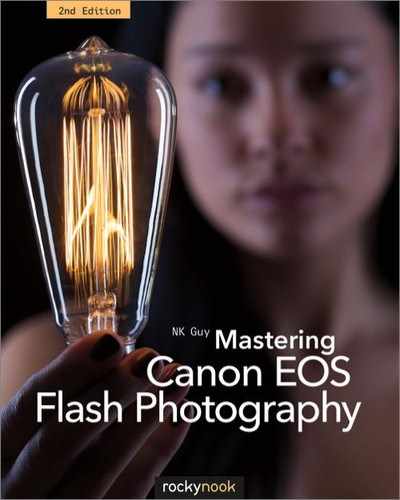Table of Contents
2.1A beginner’s configuration: Canon Digital Rebel T5/1200D with a 430EX III flash unit
2.2Flash exposure compensation (FEC)
2.5An advanced configuration: two wireless 430EX III-RT flash units
2.6A practical example of wireless flash
2.8Getting the flash off the camera
5.4The first challenge: flash synchronization
5.8The second challenge: flash metering
6.1Enabling internal flash and external Speedlites
6.2Subject and background in flash photography
6.3Ambient light metering versus flash metering
6.9EOS flash and ambient metering: a source of confusion
6.11Tv (shutter speed priority) mode
6.12Av (aperture priority) mode
6.14DEP (depth of field), A-DEP (automatic DEP), and B (Bulb) modes
6.16Fill flash ambient light reduction
6.17Flash exposure compensation (FEC)
7.7Flash technology availability summary
7.10How mechanical camera shutters work
7.12High-speed sync (HSS) / FP (focal plane) flash
7.13First and second curtain sync
7.22Safety and physical properties
9.4Swivel and tilt for bounce flash
9.7Autofocus (AF) assist light
9.9Flash exposure compensation (FEC)
9.10Flash exposure lock (FE lock or FEL)
9.13Flash exposure bracketing (FEB)
9.15Enabling second curtain sync
9.17Optical wireless E-TTL flash
9.18Integrated Speedlite transmitter: using built-in flash as master
9.19Radio wireless E-TTL flash
9.20Advanced M (metered manual) ambient metering
9.21Quick Flash/Rapid-fire mode
9.22Stroboscopic (MULTI) flash
9.23Flash exposure confirmation LED
9.26Auto Power Off/Save Energy (SE) mode
9.27Speedlite autoflash/External flash metering
9.29Custom functions (C.Fn) on flash unit
9.30External Speedlite control (ESC)
9.32Test flash (manual firing)
9.36Live View, silent shooting, and flash
9.37Cycle time and high voltage ports
10.4Choosing a manual flash unit
11.1The Seven Basic Methods for Off-camera Flash Control
11.2Off-Camera Method 1—Open flash
11.3Off-Camera Methods 2 and 3—Wired cords
11.4Off-Camera Method 2—Wired sync-only: PC cords
11.5Off-Camera Method 3—Wired with automatic metering: Canon flash cords
11.6Off-Camera Methods 4 and 5—Wireless optical control
11.7Off-Camera Method 4—Wireless optical, sync-only: optical slaves
11.8Off-Camera Method 5—Wireless optical with automatic metering: Canon optical wireless E-TTL
11.9Off-Camera Methods 6 and 7—Wireless, radio frequency (RF)
11.10 Off-Camera Method 6—Radio, sync-only
11.11 Off-Camera Method 3—Radio with automatic metering
12.4Medium-sized reflectors and diffusers
14.5Basic Speedlite portrait photography
14.6Building a studio portrait
15.1Slow shutter sync and motion
15.4Backlighting and flash in the frame
15.8Stroboscopic (MULTI) flash
15.11 Learning from the masters
Appendix A: Flash Units for Canon EOS
Appendix B: Choosing a Flash Unit
Appendix D: Custom and Personal Functions
